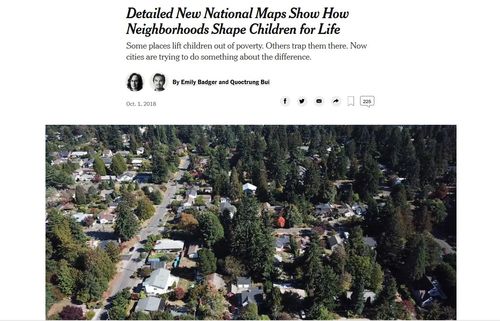
By Steve Sailer
10/02/2018

From The New York Times:
Detailed New National Maps Show How Neighborhoods Shape Children for Life
Some places lift children out of poverty. Others trap them there. Now cities are trying to do something about the difference.
By Emily Badger and Quoctrung Bui
Oct. 1, 2018… The researchers believe much of this variation is driven by the neighborhoods themselves, not by differences in what brings people to live in them. The more years children spend in a good neighborhood, the greater the benefits they receive. And what matters, the researchers find, is a hyper-local setting: the environment within about half a mile of a child’s home.
At that scale, these patterns — a refinement of previous research at the county level — have become much less theoretical, and easier to act on. …
That metric is both more specific and more mysterious. Researchers still don’t understand exactly what leads some neighborhoods to nurture children, although they point to characteristics like more employed adults and two-parent families that are common among such places. …
The answers shown here are based on the adult earnings of 20.5 million children, captured in anonymous, individual-level census and tax data that links each child with his or her parents. That data covers nearly all children in America born between 1978 and 1983, although the map here illustrates the subset of those children raised in poorer families. …
Underscoring how difficult it will be to transform these places, the federal government has spent billions in struggling neighborhoods over the years, funneling as much as $500 million into some individual census tracts since 1990, according to a tally by researchers of major placed-based initiatives like block grants and housing redevelopment programs.
“And yet we’ve never been able as a country to fully know whether and to what degree those investments were efficacious,” said Kathryn Edin, a Princeton sociologist.
Ms. Edin and other researchers working with Mr. Chetty plan to re-examine those past government programs with the new data, which makes it possible to identify where children lived when they were exposed to those investments, and what happened to them afterward.
If the answers are not clear yet, there is a hint of answers coming, now that we have fine-grained data on millions of children, now that cities alarmed by the results are taking notice, now that philanthropists are lining up to help.
In Seattle, where all these pieces have converged, housing officials were recently driving past neighborhoods their map doesn’t identify, into “opportunity areas” where families have begun to move.
“I believe the results of the data, but we all wish we knew what the distinguishing attributes are, so that we could build them in other neighborhoods,” said Andria Lazaga, the director of policy and strategic initiatives with the Seattle Housing Authority. “That’s the dream — to figure that out.”
In other words, race matters in determining what’s Magic Dirt and what’s Tragic Dirt. But once you control for race, nobody still has a clue what distinguishes Magic Dirt from Tragic Dirt.
Chetty has refined his methodology somewhat over the years, but my in-depth 2015 analysis of his work, “Moneyball for Real Estate,” remains the best introduction to what he’s doing right and what problems remain.
This is a content archive of VDARE.com, which Letitia James forced off of the Internet using lawfare.